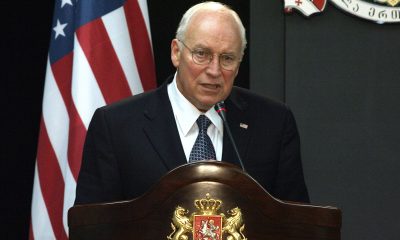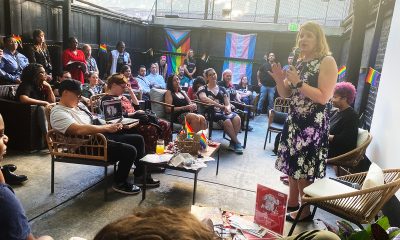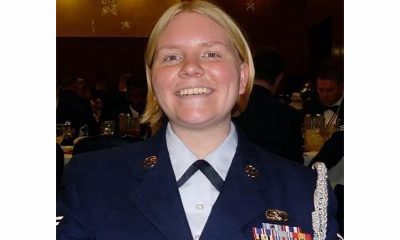National
Tension mounts as Senate prepares ‘Don’t Ask’ debate
Reid intends to file cloture petition for Tuesday vote
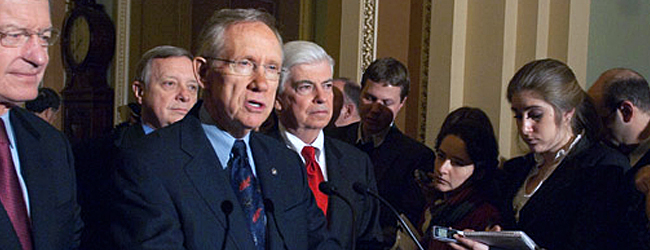
Senate Majority Leader Harry Reid (D-Nev.) has announced plans to proceed with major defense budget legislation containing “Don’t Ask, Don’t Tell” repeal language as questions linger about whether sufficient votes are present to move forward.
Reid officially announced plans to proceed with the fiscal year 2011 defense authorization bill and “Don’t Ask, Don’t Tell” on Tuesday during his press conference in the U.S. Capitol.
The majority leader said the defense authorization bill is “especially important” this year because the legislation will be a vehicle to address issues that he called “long overdue,” including “Don’t Ask, Don’t Tell.”
“I think we should choose common sense over discrimination,” Reid said. “We’re going to match our policy with our principles and finally say that in our country, everyone who steps up to serve our country should be welcome.”
Still, Reid acknowledged opposition in moving forward with the legislation and said he thinks he would have to file cloture to proceed with the bill.
“I would hope we can move to it without having to file cloture on a motion to proceed, but the way things have been going, having had to file cloture on filibuster to more than 100 different pieces of legislation, I probably will have to file cloture on that,” Reid said.
Jim Manley, a Reid spokesperson, told the Blade the senator intends to file cloture on the defense authorization bill this week for a vote on Tuesday.
Reid would file cloture after a senator objects to moving forward with the defense authorization bill with unanimous consent. After 30 hours of discussion, votes will be cast to determine whether 60 senators approve of ending the filibuster and officially moving to debate and amendments.
Asked at the conference whether he has 60 votes to proceed with the legislation, Reid replied, “We’ll sure find out.”
Aubrey Sarvis, executive director of Servicemembers Legal Defense Network, said he’s “reasonably confident” that “60 firm votes” are in the Senate to end a filibuster.
“I think we’ll actually probably end up with a couple more if needed,” Sarvis said. “I don’t think there are 40 senators who want to go on record as [being] opposed to calling up the defense authorization bill.”
Still, key Republicans in the Senate have expressed concern about the defense authorization bill and the “Don’t Ask, Don’t Tell” repeal language as well as other provisions in the legislation.
Senate Minority Leader Mitch McConnell (R-Ky.) called the repeal language a “controversial item” in response to an Blade inquiry on “Don’t Ask, Don’t Tell” during his press conference.
“The provision in the bill involves eliminating ‘Don’t Ask, Don’t Tell’ without the study, and that has also made it pretty controversial,” McConnell said.
The language in the defense authorization bill provides for repeal only after the Pentagon working group developing a plan for implemention an end to law finishes its work on Dec. 1.
An objction to proceeding would most likely come from Sen. John McCain (R-Ariz.), who has been the most vocal opponent of “Don’t Ask, Don’t Tell” repeal in the Senate. He has previoiusly objected to unanimous consent on bringing the defense authorization bill to the Senate floor.
Brooke Buchanan, a McCain spokesperson, said in a statement the senator “strongly believes” that Pentagon review should be complete before taking legislative action on “Don’t Ask, Don’t Tell.”
“As all four service chiefs have stated, we should not short circuit the ongoing Pentagon review and thereby deny our men and women in uniform a chance to have their voices heard on an important issue that affects them and their service,” she said.
Buchanan was referring to a letter from the four service chiefs made public this spring expressing their discontent with moving forward with “Don’t Ask, Don’t Tell” repeal before the Pentagon review is complete.
But Sarvis called the notion that Congress must wait for the Pentagon working group to finish its work a “tired talking point from the ‘no’ crowd.”
“Ironically, Congress, in all likelihood, will have that report before the vote is taken on the conference report in the lame duck session,” Sarvis said.
Reid said opponents of “Don’t Ask, Don’t Tell” repeal can have a vote when the legislation comes to the Senate floor on whether to strip out the language from the bill.
“They want a vote on it; they can have a vote on it,” Reid said.
Sarvis said repeal proponents have been anticipating this amendment to come to the Senate floor and are prepared to beat back such a measure.
“I think if Sen. McCain or another senator moves to strike the repeal provisions, we will prevail by a comfortable margin,” Sarvis said.
But finishing the bill before the lawmakers before lawmaker break before Election Day is seen as a major concern by repeal proponents.
Sarvis identified “time” as his biggest concern heading into Senate debate on “Don’t Ask, Don’t Tell” while emphasizing the importance of a Senate vote on the defense authorization bill in September before lawmakers adjourn for the break.
“As long as there are strong opponents in the Senate, they will try to tie this up and ensure that we don’t finish in September or early October,” Sarvis said. “We can’t allow that to happen.”
Sarvis said the lame duck session after Election Day is limited and bills that haven’t already made it through both chambers of Congress are less likely to meet approval.
DREAM Act comes into play
Also during the conference, Reid said he wants to amend the defense authorization bill so that it would include the Development, Relief and Education for Alien Minors Act, or DREAM Act, an immigration-related bill.
The legislation would provide a path to citizenship for young, undocumented immigrants pursuing a college education or position in the U.S. armed forces.
“Kids who grew up as Americans should be able to get their green card if they go to college or serve in the military,” Reid said.
The majority leader noted a number of U.S. service members are Hispanic and said “it’s really important that we move forward on this legislation that we tried to work on.”
Reid said moving forward on the DREAM Act as part of the defense authorization bill is partially in response what he called his inability to pass comprehensive immigration reform legislation this Congress.
“I know we can’t do comprehensive immigration reform,” Reid said. “I’ve tried so very, very hard. I’ve tried different iterations of this, but those Republicans we had in the last Congress have left us.”
McConnell cited the inclusion of the DREAM Act as a potentially “extraneous” amendment to the defense authorization bill.
The minority leader also was critical of Reid said he wants to address the issue of “secret holds” on presidential nominees as part of the defense authorization bill.
“It’s made it needlessly controversial,” McConnell said. “I can’t tell you right now how easy it will be to go forward with that bill, but it’s certainly created an element of controversy that would not have been otherwise there.”
Steve Ralls, a spokesperson for Immigration Equality, an LGBT immigration group, said his organzation was not part of discussion of including the DREAM Act as part of the defense authorization bill, but supports its passage.
“I can’t predict what the impact is going to be, but we certainly support the DREAM Act and I would say that we believe that the Senate majority leader is the right person to make the decision on how best to move forward,” Ralls said.
Sarvis said he doesn’t know whether this measure would complicate efforts for “Don’t Ask, Don’t Tell” repeal.
“I don’t think it has to,” Sarvis said. “I think they are two separate issues and, at the end of the day, I think each one of these amendments are going to have to stand or fall on their own.”
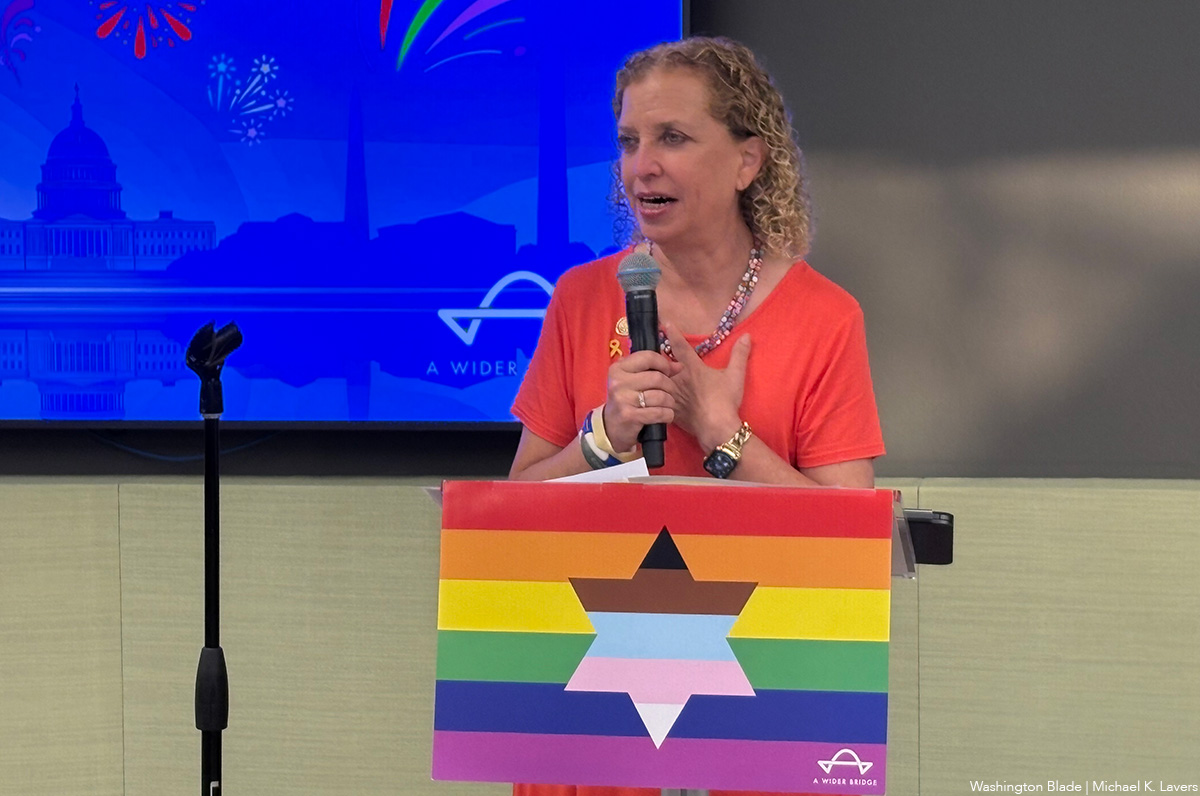
A Wider Bridge on Friday announced it will shut down at the end of the month.
The group that “mobilizes the LGBTQ community to fight antisemitism and support Israel and its LGBTQ community” in a letter to supporters said financial challenges prompted the decision.
“After 15 years of building bridges between LGBTQ communities in North America and Israel, A Wider Bridge has made the difficult decision to wind down operations as of Dec. 31, 2025,” it reads.
“This decision comes after challenging financial realities despite our best efforts to secure sustainable funding. We deeply appreciate our supporters and partners who made this work possible.”
Arthur Slepian founded A Wider Bridge in 2010.
The organization in 2016 organized a reception at the National LGBTQ Task Force’s Creating Change Conference in Chicago that was to have featured to Israeli activists. More than 200 people who protested against A Wider Bridge forced the event’s cancellation.
A Wider Bridge in 2024 urged the Capital Pride Alliance and other Pride organizers to ensure Jewish people can safely participate in their events in response to an increase in antisemitic attacks after Hamas militants attacked Israel on Oct. 7, 2023.
The Jewish Telegraphic Agency reported authorities in Vermont late last year charged Ethan Felson, who was A Wider Bridge’s then-executive director, with lewd and lascivious conduct after alleged sexual misconduct against a museum employee. Rabbi Denise Eger succeeded Felson as A Wider Bridge’s interim executive director.
A Wider Bridge in June honored U.S. Rep. Debbie Wasserman Schultz (D-Fla.) at its Pride event that took place at the Capital Jewish Museum in D.C. The event took place 15 days after a gunman killed two Israeli Embassy employees — Yaron Lischinsky and Sarah Milgrim — as they were leaving an event at the museum.
“Though we are winding down, this is not a time to back down. We recognize the deep importance of our mission and work amid attacks on Jewish people and LGBTQ people – and LGBTQ Jews at the intersection,” said A Wider Bridge in its letter. “Our board members remain committed to showing up in their individual capacities to represent queer Jews across diverse spaces — and we know our partners and supporters will continue to do the same.”
Editor’s note: Washington Blade International News Editor Michael K. Lavers traveled to Israel and Palestine with A Wider Bridge in 2016.
The White House
‘Trump Rx’ plan includes sharp cuts to HIV drug prices
President made announcement on Friday

President Donald Trump met with leaders from some of the world’s largest pharmaceutical companies at the White House on Friday to announce his new “Trump Rx” plan and outline efforts to reduce medication costs for Americans.
During the roughly 47-minute meeting in the Roosevelt Room, Trump detailed his administration’s efforts to cut prescription drug prices and make medications more affordable for U.S. patients.
“Starting next year, American drug prices will come down fast, furious, and will soon be among the lowest in the developed world,” Trump said during the meeting. “For decades, Americans have been forced to pay the highest prices in the world for prescription drugs by far … We will get the lowest price of anyone in the world.”
Trump signed an executive order in May directing his administration “to do everything in its power to slash prescription drug prices for Americans while getting other countries to pay more.”
“This represents the greatest victory for patient affordability in the history of American health care, by far, and every single American will benefit,” he added.
Several pharmaceutical executives stood behind the president during the announcement, including Sanofi CEO Paul Hudson, Novartis CEO Vas Narasimhan, Genentech CEO Ashley Magargee, Boehringer Ingelheim (USA) CEO Jean-Michel Boers, Gilead Sciences CEO Dan O’Day, Bristol Myers Squibb General Counsel Cari Gallman, GSK CEO Emma Walmsley, Merck CEO Robert Davis, and Amgen Executive Vice President Peter Griffith.
Also in attendance were Health and Human Services Secretary Robert F. Kennedy Jr., Commerce Secretary Howard Lutnick, Centers for Medicare and Medicaid Services Administrator Mehmet Oz, and Food and Drug Administration Commissioner Marty Makary.
Under the Trump Rx plan, the administration outlined a series of proposed drug price changes across multiple companies and therapeutic areas. Among them were reductions for Amgen’s cholesterol-lowering drug repatha from $573 to $239; Bristol Myers Squibb’s HIV medication reyataz from $1,449 to $217; Boehringer Ingelheim’s type 2 diabetes medication jentadueto from $525 to $55; Genentech’s flu medication xofluza from $168 to $50; and Gilead Sciences’ hepatitis C medication epclusa from $24,920 to $2,425.
Additional reductions included several GSK inhalers — such as the asthma inhaler advair diskus 500/50, from $265 to $89 — Merck’s diabetes medication januvia from $330 to $100, Novartis’ multiple sclerosis medication mayzent from $9,987 to $1,137, and Sanofi’s blood thinner plavix from $756 to $16. Sanofi insulin products would also be capped at $35 per month’s supply.
These prices, however, would only be available to patients who purchase medications directly through TrumpRx. According to the program’s website, TrumpRx “connects patients directly with the best prices, increasing transparency, and cutting out costly third-party markups.”
Kennedy spoke after Trump, thanking the president for efforts to lower pharmaceutical costs in the U.S., where evidence has shown that drug prices — including both brand-name and generic medications — are nearly 2.78 times higher than prices in comparable countries. According to the Pharmaceutical Research and Manufacturers of America, roughly half of every dollar spent on brand-name drugs goes to entities that play no role in their research, development, or manufacturing.
“This is affordability in action,” Kennedy said. “We are reversing that trend and making sure that Americans can afford to get the life-saving solutions.”
Gilead CEO Dan O’Day also spoke about how the restructuring of drug costs under TrumpRx, combined with emerging technologies, could help reduce HIV transmission — a virus that, if untreated, can progress to AIDS. The LGBTQ community remains disproportionately affected by HIV.
“Thank you, Mr. President — you and the administration,” O’Day said. “I think this objective of achieving the commitment to affordability and future innovation is extraordinary … We just recently launched a new medicine that’s only given twice a year to prevent HIV, and we’re working with Secretary Kennedy and his entire team, as well as the State Department, as a part of your strategy to support ending the epidemic during your term.
“I’ve never been more optimistic about the innovation that exists across these companies and the impact this could have on America’s health and economy,” he added.
Trump interjected, asking, “And that’s working well with HIV?”
“Yes,” O’Day replied.
“It’s a big event,” Trump said.
“It literally prevents HIV almost 100 percent given twice a year,” O’Day responded.
A similar anti-HIV medication is currently prescribed more than injectable form mentioned by O’Day. PrEP, is a medication regimen proven to significantly reduce HIV infection rates for people at high risk. Without insurance, brand-name Truvada can cost roughly $2,000 per month, while a generic version costs about $60 per month.
Even when medication prices are reduced, PrEP access carries additional costs, including clinic and laboratory fees, office visits, required HIV and sexually transmitted infection testing, adherence services and counseling, and outreach to potentially eligible patients and providers.
According to a 2022 study, the annual total cost per person for PrEP — including medication and required clinical and laboratory monitoring — is approximately $12,000 to $13,000 per year.
The TrumpRx federal platform website is now live at TrumpRx.gov, but the program is not slated to begin offering reduced drug prices until January.
The White House
EXCLUSIVE: Democracy Forward files FOIA lawsuit after HHS deadnames Rachel Levine
Trans former assistant health secretary’s name changed on official portrait

Democracy Forward, a national legal organization that works to advance democracy and social progress through litigation, policy and public education, and regulatory engagement, filed a lawsuit Friday in federal court seeking to compel the U.S. Department of Health and Human Services to release information related to the alteration of former Assistant Secretary for Health Adm. Rachel Levine’s official portrait caption.
The lawsuit comes in response to the slow pace of HHS’s handling of multiple Freedom of Information Act requests — requests that federal law requires agencies to respond to within 20 working days. While responses can take longer due to backlogs, high request volumes, or the need for extensive searches or consultations, Democracy Forward says HHS has failed to provide any substantive response.
Democracy Forward’s four unanswered FOIA requests, and the subsequent lawsuit against HHS, come days after someone in the Trump-Vance administration changed Levine’s official portrait in the Hubert H. Humphrey Building to display her deadname — the name she used before transitioning and has not used since 2011.
According to Democracy Forward, HHS “refused to release any records related to its morally wrong and offensive effort to alter former Assistant Secretary for Health Admiral Rachel Levine’s official portrait caption.” Levine was the highest-ranking openly transgender government official in U.S. history and served as assistant secretary for health and as an admiral in the U.S. Public Health Service Commissioned Corps from 2021 to 2025.
Democracy Forward President Skye Perryman spoke about the need to hold the Trump-Vance administration accountable for every official action, especially those that harm some of the most targeted Americans, including trans people.
“The question every American should be asking remains: what is the Trump-Vance administration hiding? For an administration that touts its anti-transgender animus and behavior so publicly, its stonewalling and silence when it comes to the people’s right to see public records about who was behind this decision is deafening,” Perryman said.
“The government’s obligation of transparency doesn’t disappear because the information sought relates to a trailblazing former federal official who is transgender. It’s not complicated — the public is entitled to know who is making decisions — especially decisions that seek to alter facts and reality, erase the identity of a person, and affect the nation’s commitment to civil rights and human dignity.”
“HHS’s refusal to respond to these lawful requests raises more serious concerns about transparency and accountability,” Perryman added. “The public has every right to demand answers — to know who is behind this hateful act — and we are going to court to get them.”
The lawsuit also raises questions about whether the alteration violated federal accuracy and privacy requirements governing Levine’s name, and whether the agency improperly classified the change as an “excepted activity” during a lapse in appropriations. By failing to make any determination or produce any records, Democracy Forward argues, HHS has violated its obligations under federal law.
The case, Democracy Forward Foundation v. U.S. Department of Health and Human Services, was filed in the U.S. District Court for the District of Columbia. The legal team includes Anisha Hindocha, Daniel McGrath, and Robin Thurston.
The Washington Blade reached out to HHS, but has not received any comment.
The lawsuit and four FOIA requests are below:
-

 Politics2 days ago
Politics2 days agoLGBTQ Democrats say they’re ready to fight to win in 2026
-

 District of Columbia2 days ago
District of Columbia2 days agoBrian Footer suspends campaign for Ward 1 D.C. Council seat
-

 Chile4 days ago
Chile4 days agoFar-right José Antonio Kast elected Chile’s next president
-

 Opinions2 days ago
Opinions2 days agoLighting candles in a time of exhaustion

